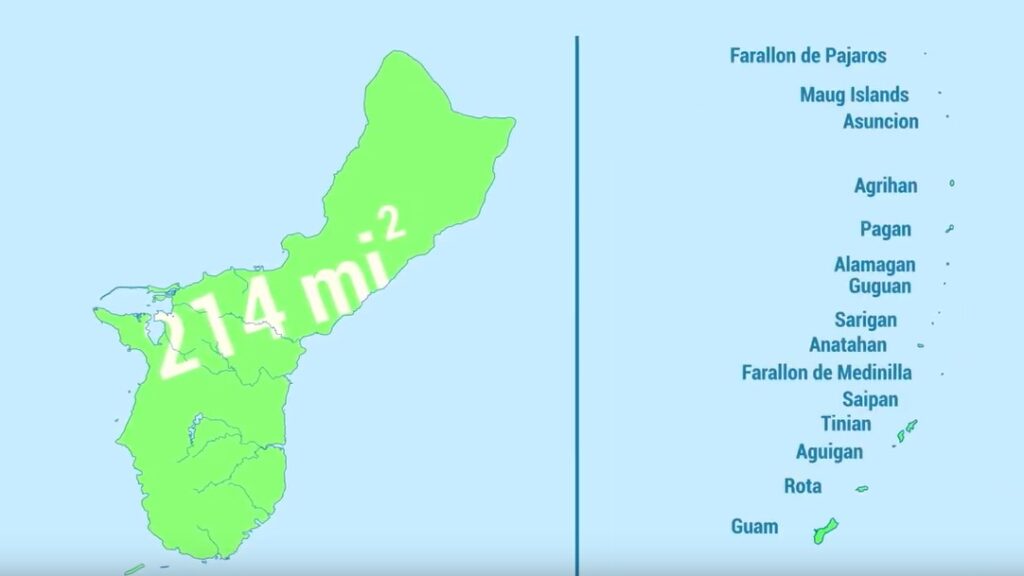
The Mariana Islands (/ˌmæriˈɑːnə/; also the Marianas; in Chamorro: Manislan Mariånas) are a crescent-shaped archipelago comprising the summits of fifteen longitudinally oriented, mostly dormant volcanic mountains in the northwestern Pacific Ocean, between the 12th and 21st parallels north and along the 145th meridian east. They lie south-southeast of Japan, west-southwest of Hawaii, north of New Guinea and east of the Philippines, demarcating the Philippine Sea’s eastern limit. They are found in the northern part of the western Oceanic sub-region of Micronesia, and are politically divided into two jurisdictions of the United States: the Commonwealth of the Northern Mariana Islands and, at the southern end of the chain, the territory of Guam. The islands were named after the influential Spanish queen Mariana of Austria following their colonization in the 17th century.
The Commonwealth of the Northern Mariana Islands
The Commonwealth of the Northern Mariana Islands (CNMI) emerged from the Trust Territory of the Pacific Islands (TTPI) which the United States administered on behalf of the United Nations from 1947 until Palau, the last member of the TTPI to choose its own political future, became an independent country 1994. The Federal law (the Covenant) making the CNMI a U.S. territory passed in 1975. The CNMI adopted its constitution in 1977, and its first constitutional government took office in 1978. The CNMI came under Federal minimum wage regulations in 2007 and immigration law in 2008. In June 2009, the U.S. Department of Homeland Security takes over the CNMI’s immigration and border controls.
The Northern Mariana Islands, officially the Commonwealth of the Northern Mariana Islands (CNMI; Chamorro: Sankattan Siha Na Islas Mariånas; Carolinian: Commonwealth Téél Falúw kka Efáng llól Marianas), is an unincorporated territory and commonwealth of the United States consisting of 14 islands in the northwestern Pacific Ocean. The CNMI includes the 14 northernmost islands in the Mariana Archipelago; the southernmost island, Guam, is a separate U.S. territory. The Northern Marianas Islands are listed by the United Nations as one of 17 non-self governing territories.
At a landmass of 183.5 square miles (475.26 km2) and with 47,329 people were living in the CNMI, as of a 2020 census, the vast majority of the population resides on Saipan, Tinian, and Rota. The other islands of the Northern Marianas are sparsely inhabited; the most notable among these is Pagan, which for various reasons over the centuries has experienced major population flux, but formerly had residents numbering in the thousands.
The administrative center is Capitol Hill, a village in northwestern Saipan.
The Mariana Islands were the first islands settled by humans in Remote Oceania. Incidentally it is also the first and the longest of the ocean-crossing voyages of the Austronesian peoples, and is separate from the later Polynesian settlement of the rest of Remote Oceania.
Guam - Guahan "We Have"
Guam is a challenging place to summarize in just a few words.
It’s so much more than its miles upon miles of sandy beaches, waterfalls, coconut trees, and coral reef ready for you to explore. Our unparalleled sunsets, starry night skies, and rolling mountains and valleys help paint a picture of what you’ll find here but don’t go nearly far enough. Experience a thrilling adventure on land or at sea.
Unravel 4,000 years of intriguing history — ranging from pre-colonial culture and archaeological sites and the site where Magellan’s ships landed, to Spanish forts and WWII battle sites — Guam has many stories to tell.
But this is not an island stuck in the past. Our culture and history live on with a cosmopolitan twist, as seen through our eclectic cuisine, great places to stay, fun and unique festivals, and vibrant art, music, and fashion scenes rooted in pride of place and heritage. Our people’s eyes are fixed on the horizon while their feet are firmly planted in their native soil.
Words fall short. There’s only one way to truly understand the beauty and magic of Guam: first-hand experience.
We invite you to come experience for yourself why Guam is a destination like no other.